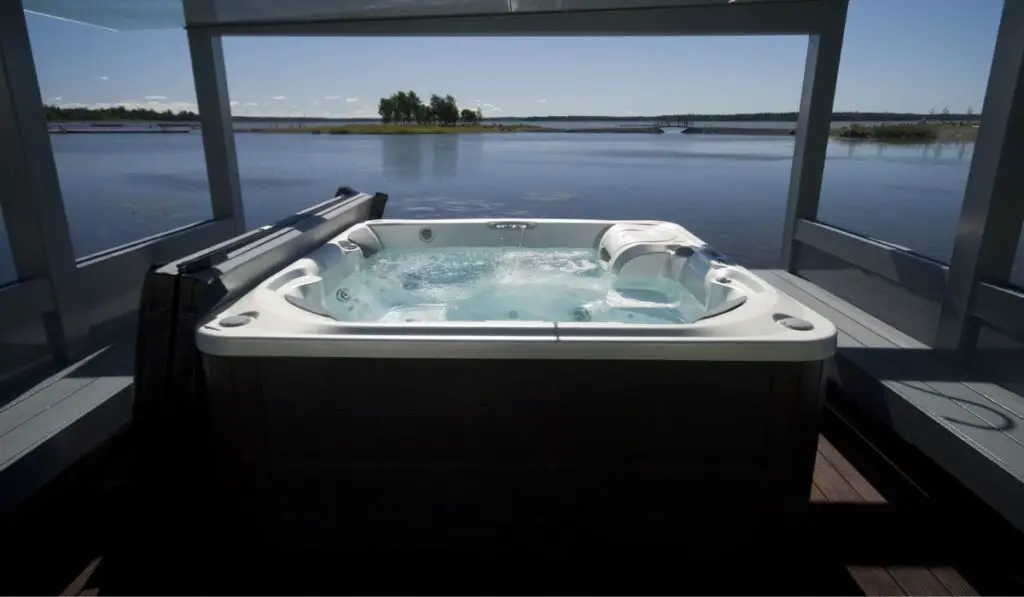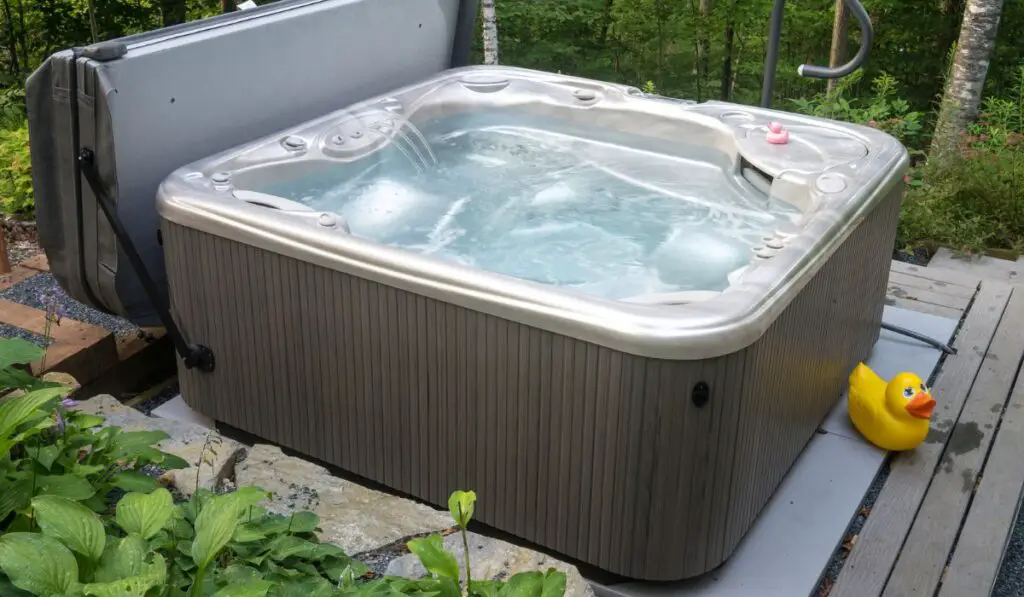A hot tub is probably one of the bulkiest things you’ll ever own. From the shell to the frame to the fittings, a lot of heavy material goes into these tubs, and the weight only increases when you fill one with water That means you’ll need a foolproof plan to move your tub — and a solid foundation to keep it in place. But first, how much does a hot tub weigh?
An average 4-person acrylic hot tub weighs about 500 lbs dry and 3,000 lbs when full. A fiberglass tub of the same size weighs about 330 lbs dry and 2,500 lbs filled, while a molded plastic tub weighs even less. Size and materials are the two most important factors determining the weight.
For most people, the weight of the hot tub isn’t a big deal until they plan to move it or need to put it on a second-story deck. At that point, the weight becomes the most important factor. Still, it’s always best to know how much your tub weighs so you can be prepared for anything. Let’s find out a few ways to determine the weight of a hot tub and look at why it’s so important to know.
What’s the Weight of the Average Hot Tub?

Hot tubs come in all shapes and sizes, so the range in weights is pretty wide. A standard two-person hot tub can weigh between 300 and 500 pounds when empty. When you factor in the water weight (about 8.3 pounds per gallon), the average full hot tub can weigh between 2,000 and 3,000 pounds.
A six-person hot tub can weigh even more — sometimes upwards of 700 pounds when empty. They usually hold 300-350 gallons of water, so these tubs can weigh over 4,000 pounds when full.
Some eight-person hot tubs, meanwhile, can weigh as much as 1,000 pounds dry and close to 5,000 pounds with water.
How to Determine the Weight of Your Tub
The weight of a particular hot tub depends on the size of the hot tub, the materials used in its construction, and the water capacity.
Usually, the manufacturer lists the tub’s dry and full weights in the product description. You can also find this information on their website and in owner’s manuals. But if you can’t track down those numbers, there’s a simple way to estimate the weight of your tub.
Dry Weight
The dry weight of the hot tub largely depends on the materials used in its construction. If you have an inflatable soft plastic tub, it might not go over 50 pounds. But a more durable hard plastic, acrylic, or wooden tub can weigh a few hundred pounds.
Since most tubs are made of a combination of materials, it can be difficult to find an accurate dry weight just by looking at the tub. Your best bet is to find similar models and see what the manufacturers have stated about their weight.
But as a rule of thumb, the bigger the tub, the higher the weight, and the more materials used in construction, the heavier it will be.
Water Weight
Water capacity, on the other hand, is pretty easy to figure out. Once you know how much water your tub can hold, you can find how much the water will weigh.
First, find the inside dimensions of the tub (length x width x height). You can usually find these in the product description or measure them yourself. Multiply these numbers together to get the tub’s volume in cubic feet.
For example, let’s say your hot tub is 7 feet long, 4 feet wide, and 2.5 feet tall. The volume would be:
7 x 4 x 2.5 = 70 cubic feet
Now, multiply the volume by 61.7 (water weight per cubic foot).
70 x 61.7 = 4,319 pounds
So, when full, the water in your tub will weigh close to 4,300 pounds.
Add the weight of your tub and the water together to estimate your tub’s total weight.
For example, let’s say you’ve got a wooden tub that weighs 400 pounds dry, the total weight of the tub would be: 400 + (70 x 61.7) = 4,719 pounds.
Which Material Is the Heaviest?
The heaviest hot tubs are made of cast iron, followed by the acrylic and concrete models. However, cast iron tubs aren’t as common, so acrylic tubs are usually the heaviest that you’ll find.
Here is a quick breakdown of the weights of a four-person hot tub made out of different materials:
- Cast iron – 700 lbs (317 kg)
- Acrylic – 500 lbs (226 kg)
- Concrete – 400 lbs (181 kg)
- Fiberglass – 330 lbs (150 kg)
- Rotomolded Plastic – 300 lbs (136 kg)
- Wood – 300 lbs (136 kg)
A hot tub is made of a combination of materials, so your hot tub might weigh below or above these averages. However, the shell is almost always made of a single material, so the total weight is estimated based on that.
How Much Does It Cost to Move a Hot Tub?
Moving a hot tub isn’t easy; they’re big, bulky, and often oddly shaped, which makes them difficult to maneuver. However, the weight of your hot tub may become the single most important factor when trying to move it.
For example, if you’re planning on moving your small tub across town, you can probably get away with enlisting help from friends and renting a truck. It’ll probably cost you less than $200, maybe even less than $100, if you’re lucky.
But if you have a large tub and have to move it far away, you’ll need to hire professional movers.
Then the cost will depend on the distance, the size and weight of your tub, and whether you need any extra services like disassembly/reassembly or special permits. In this case, moving your hot tub can cost you upwards of $1,000.
However, now imagine you only need to move your tub a few feet to the other side of your backyard. But it’s a big acrylic tub that weighs 900 pounds without water. In this case, you’d need a crane and help from professional movers (for safety), which can cost you a pretty penny.
So, it all comes down to the weight of your tub. The heavier it is, the more difficult and expensive it will be to move.
What Type of Foundation Is Best for a Hot Tub?

A sturdy foundation is important for any hot tub, but it becomes even more critical when your tub is on the heavier side. Without a proper foundation, your tub could sink into the ground, fall off balance, or even crack under pressure.
So, let’s look at the best foundation options for a hot tub, based on weight.
When planning for placement and foundation of hot tubs, always factor in the weight of people using the tub and the tub’s weight.
Concrete
Concrete is probably the most popular foundations for hot tubs, and for good reason. Concrete foundations are extremely durable, easy to install, and can support even the heaviest hot tubs.
You can reinforce the foundation with steel mesh or rebar to be extra safe. Excavate the area where you want your tub to go, pour the concrete at least 4 to 6 inches thick, and let it cure.
The only downside to concrete foundations is that they’re not very portable. So you need to be sure where you want your hot tub before pouring the foundation.
Wooden Decks
If you already have a wooden deck in your backyard, you might be tempted to put your hot tub on top of it. Depending on the type of wood and construction, decks can actually support quite a bit of weight.
For example, a pressure-treated lumber deck can support up to 1,500 pounds (680 kg) per square foot. However, decks higher than 24 inches (2 feet) off the ground might not be the best option.
So, if you decide to put your hot tub on a wooden deck, hire a professional to assess the weight capacity first. And reinforce the deck with support beams if needed.
Gravel
Gravel is a great option if you don’t want to pour a concrete foundation but still need something sturdy. It’s easy to install and can support a hot tub weighing up to 5,000 pounds (2,268 kg).
You only need to excavate 6 inches (15 cm) of soil, level it out, and then fill the first few inches with medium size gravel. Use a pea gravel mix for the rest until you reach the desired level. Just make sure to compact the gravel as you go to avoid settling.
You can also cover it with pavers for a more finished look. And your hot tub should be good to go.
Pre-Made Hot Tub Base
If you don’t want to deal with the hassle of pouring a foundation yourself, you can always buy a pre-made one (on Amazon). These are usually made out of metal and plastic and can support up to 100 pounds per square foot.
You can find them online or at your local store where hot tubs are sold. They typically cost between $100 and $500, which is more expensive than other options. But they’re very easy to install and don’t require any special skills or tools.
Moving a Hot Tub Yourself vs. Hiring Professionals
While it’s tempting to save some money and try to move your hot tub yourself, it’s not always the best idea. Hot tubs are very delicate, especially the control panels and electric components.
Plus, they’re extremely heavy and difficult to move without the proper equipment. So, unless you have experience moving heavy objects, we recommend hiring professionals.
But if you think you can handle it, keep the following tips in mind:
- Ensure you have all the necessary equipment, like a dolly, straps, and blankets. You’ll also need a way to disconnect the power and water lines without damaging them.
- Get help from friends or family. And make sure they’re capable of lifting the weight.
- Hire a truck big enough to fit your hot tub and any equipment you might need.
- Take your time, plan how you’re going to move it, and be careful not to damage your hot tub or hurt yourself in the process.
